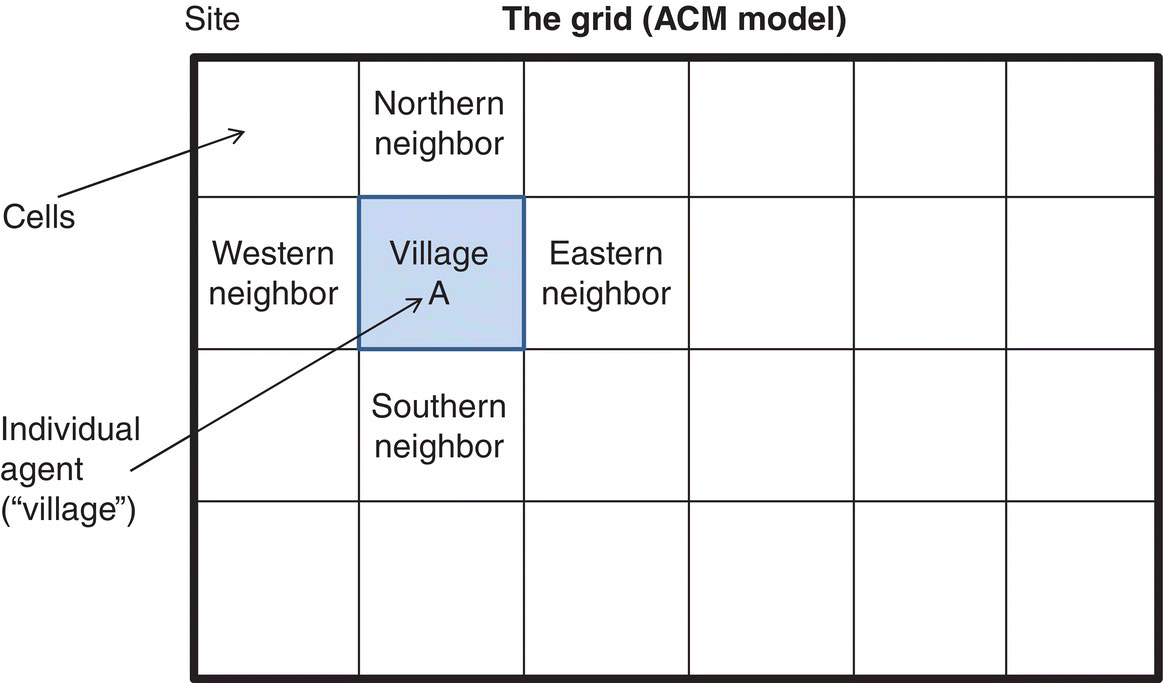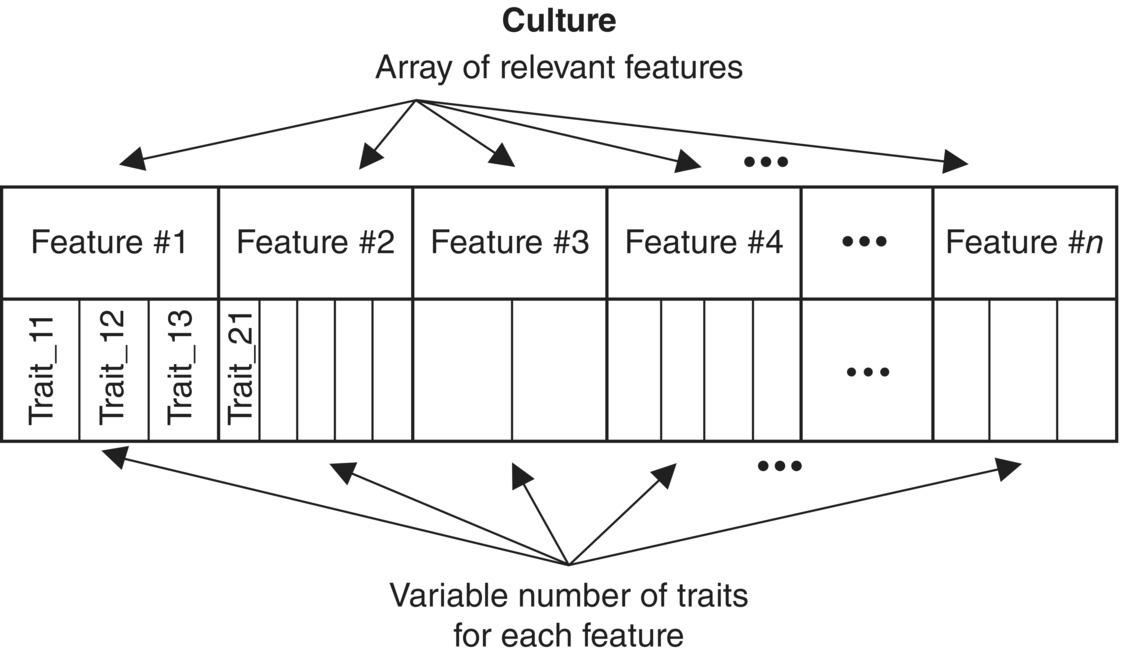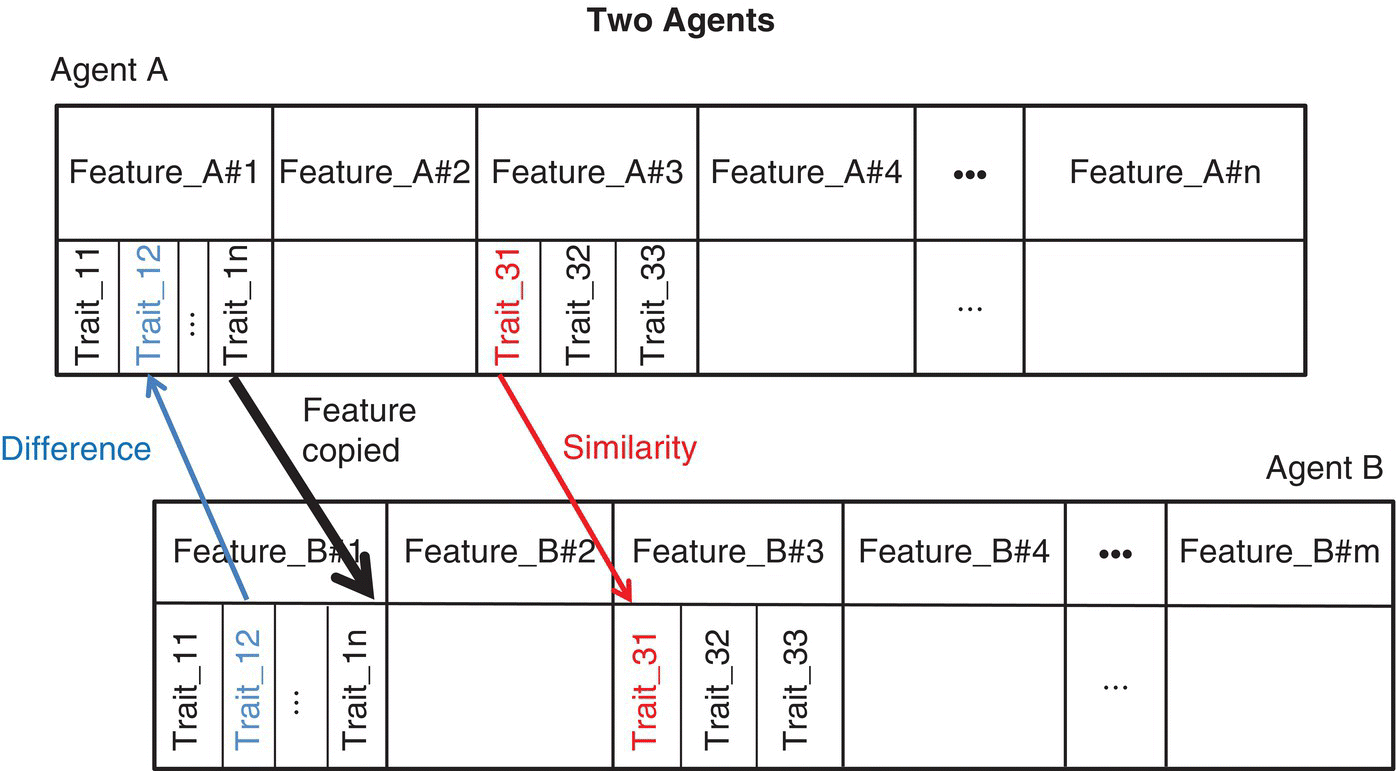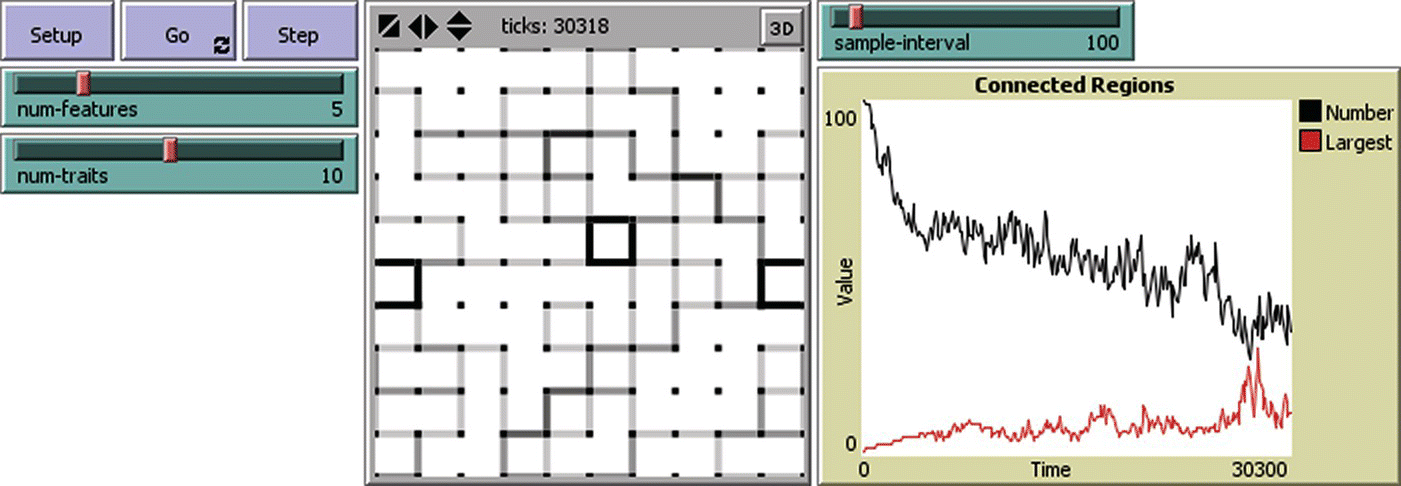7
Culture Dissemination Model
This model represents a classic reference in social and political sciences. From a philosophy of science perspective, Axelrod (1997: 206) described computational and simulation modelling as a speculative experimental scenario called ever since a virtual experiment. It is based on the classic idea of constructing possible, believable scenarios of the future developments of a dynamic system introduced by Jay Forrester in the early 1950s as a forecasting model‐based simulation technique. Beyond the heritage of this classical tradition in employing computational technology in social studies, Axelrod’s computational and simulation modelling approach brought, nevertheless, something new: its main relevance and the power of his arguments reside in the chosen domain (attitude change, social influence and culture dissemination), the technology (agent‐based modelling), the constructivism of the modelling approach (bottom‐up) and the principle of social interaction (methodological individualism).
Axelrod aims at identifying the theoretical and experimental support for developing an experimental version of both social and political sciences; his approaches are well known and famous for their simplicity and for promoting the concepts long expected to change the spirit of theory development in these sciences: replace empirical tradition with the generative alternative. Again, his attempt is not unique: the late 1990s witnessed a boost in new research approaches; take that of Epstein and Axtell (1996) as perhaps the best example, which proved that the idea of experimental social and political science has long gained new background and tools from the sciences of the artificial – AI, ALife and artificial agents – which have massively and decisively penetrated the traditional empirical background and changed minds, means and aims.1
Axelrod’s Model of Culture Dissemination (ACM) is relevant to our approach for at least one reason: it opens up the door for experimental research in areas which have long kept distant and resistant to the new technologies, like culture modelling in general and political attitudes in particular. For this would lead us to understand the different ways in which the ACM modelling concept has influenced the area we target in this volume. Its underlying philosophy unites complexity and self‐organizing social system concepts and theories with the principles of experimental research, the constructivist philosophy of modelling and simulation, and with the new technologies of the artificial, thus becoming the turning point of profound paradigmatic changes in the computational and simulation research in social science in general and in particular in political science. It has been inspiring and offered a reference for future complex developments in several areas: dynamics of culture and cultural drift, dynamics of public opinion and last but not least, political attitudes.
For the purpose of our study, there are several aspects which need to be emphasized and briefly explained with regard to ACM: the principle of social action at the micro level and how it generates culture dissemination and change phenomena at the macro level. In order to understand all this, we will briefly present in the following subsections (i) the individual agent, (ii) the social influence mechanism and (iii) the emergence of macro‐level phenomena.
Modelling Principles
Axelrod suggests a methodological individualism approach inspired by Boudon (1986): individuals who interact with one another constitute the source of social and political motion. Another principle is that people look for like‐minded others to communicate with (homophily, as introduced by Homans (1950) and Rogers (1983)). A third principle is that culture dissemination could be viewed as an abstract form of communication, as communication suffices for exchanges between individuals which enhance social influence.
Conceptual Model: A Computational and Simulation Model of Culture Change
ACM works with an artificial social environment, which is defined as a geographical space with finite borders (Figure 7.1). The individual agents in this environment represent villages characterized by different cultures (Figure 7.2).

Figure 7.1 The environment is represented as a grid of 10 × 10 cells. Agents are represented as cells on a square grid. Agents are ‘villages’; they are geographically situated in this environment such that in each cell there is an individual agent. Each agent has four neighbours (von Neumann neighbours). Agents interact with each other following simple rules which define their behaviour: (1) selection and (2) cultural change.

Figure 7.2 Culture representation.
Axelrod’s model defines a culture in the most abstract way: a culture is defined as a set of features. Each feature has a set of traits, and each trait can have a specific value, and may differ from one individual agent to another.
The model is based on cellular automata. The environment is represented as a square grid of 10 × 10 cells, where each cell is occupied by an individual agent (i.e. a village). The individual agents are able to interact only with their von Neumann neighbours, so that an individual agent will communicate with its direct neighbouring agents placed at northern, southern, eastern and western positions.
Each feature can have up to 10 traits, and a trait can have a value which is a continuous value between 0 and 1. At the beginning of a simulation run, the traits are initialized from a normal distribution of values.
The individual agents are able to interact with their neighbours following a single rule: similarity. The similarity is viewed as a number of features/traits shared by any two individual agents. For a higher number of shared traits, the chances of individual agents getting in contact and communicating increase, so that the first thing an individual agent will do is to look for other agents with which it has at least one trait in common. The number of shared traits shows the degree of similarity. The similarity‐based interaction models the interaction based on the homophily principle that likes attract. An individual agent will therefore look for like‐minded others to contact and communicate with, thus justifying some other basic mechanisms, like the need to avoid conflicts and to expect from the other agent confirmation of its own values, preferences, choices or attitudes. The similarity‐based mechanism is the only mechanism involved in the communication between individual agents.
Culture change is made effective by means of a copy mechanism (i.e. convergence mechanism): the more often they interact, the faster the convergence of their cultures.
Operational Model
The model operates in two phases: a phase which concerns the selection of an individual agent for further interaction, and a phase in which culture change occurs.
Selection Phase
The selection mechanism makes each agent select another agent to interact with. The selecting process is based on the evaluation of agents’ degree of similarity: similar agents have more chances to interact as interaction takes place only if two agents share features. An interaction occurs with a probability which is equal to the degree of similarity between two agents, that is, the number of shared features from the total features.
Cultural change is based on a convergence mechanism which operates by feature transmission from one agent to another.
An interaction always results in a culture change by letting the agent who initiates an interaction copy a feature (at random) from another agent. A feature is selected from those features which differ between the two agents and its trait is copied by the agent who initiated interaction. Thus, their similarity increases the chances to interact, and the more they interact, the more similar they become.
While enhancing the dynamic, nonlinear nature of the interactions among individual agents, the similarity‐based interactions prove fast convergence toward either monoculture emergence or toward deep polarization.
Change Phase
The dynamics of the culture dissemination model are formally described as follows.
Let C be a culture, and vi, vj be agents  (see Figure 7.3) and let α be a feature in culture C on which the two agents have different traits:
(see Figure 7.3) and let α be a feature in culture C on which the two agents have different traits:


Figure 7.3 Two agents have a similar feature and a different feature. An interaction might occur with a probability which is equal to the degree of similarity (i.e. proportion of similar features). In the case that the interaction finally occurs, the agent that initiates the interaction (agent A) selects (at random) another feature from agent B on which they differ and copies it.
As the two agents vi and vj have a similar feature ϕ

their interaction results in agent vi selecting either α or any other feature β of the agent vj on which they have different traits:

and copying the trait from agent vj:

where ‘←’ denotes a ‘copy’ operation and  denotes the kth trait on feature β for agent vi in culture C (
denotes the kth trait on feature β for agent vi in culture C ( , with m the total number of traits a feature has in culture C), as specified in Step 2 in the formal statement of the model dynamics (Axelrod, 1997: 208).
, with m the total number of traits a feature has in culture C), as specified in Step 2 in the formal statement of the model dynamics (Axelrod, 1997: 208).
Simulation Results
The emergence of culture regions is differently associated with three factors: culture complexity, territorial size and the patterns of local convergence and global polarization which emerge from the model dynamics.
- Culture complexity in terms of the number of features and traits per feature: fast polarization is enhanced by a small number of different features and traits. As the number of different features increases, the convergence is slower and the diversity is preserved for longer.
- The territory size is an unexpected result of the simulations: the larger the territory, the more chances that diversity is preserved.
- The model dynamics consist of patterns of convergence and patterns of polarization (see demo in Figure 7.4).

Figure 7.4 Experimental results. Simulations were performed on the NetLogo site with the simulator: ‘Dissemination of Culture’ by Iain Weaver (see Web Resources section).
Web Resources
NetLogo User Community Models
Dissemination of culture by Iain Weaver at http://ccl.northwestern.edu/netlogo/models/community/Dissemination%20of%20Culture.
References
- Axelrod, R. (1997) The dissemination of culture: a model with local convergence and global polarization. Journal of Conflict Resolution, 41(2), 203–226.
- Boudon, R. (1986) Theories of Social Change. University of California Press.
- Casti, J. (1997) Would‐Be Worlds: How Simulation Is Changing the Face of Science, New York: John Wiley & Sons.
- Epstein, J.M. and Axtell, R.L. (1996) Growing Artificial Societies: Social Science from the Bottom Up. MIT Press, Cambridge, MA.
- Gilbert, N. and Troitzsch, K.G. (2005) Simulation for the Social Scientist, 2nd edn. Open University Press/McGraw‐Hill.
- Homans, G.C. (1950) The Human Group. Harcourt, Brace and Company, New York.
- Huckfeldt, R. (2014) Networks, Contexts, and the Combinatorial Dynamics of Democratic Politics, Advances in Political Psychology, 35, Suppl. 1, 43–68.
- Rogers, E.M. (1983) Diffusions of Innovations, 3rd edn. Free Press.